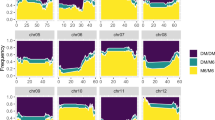Summary
Two of the four strands of a bivalent are recovered together in tetraploid progeny arising from 4x-2x matings. This provides a method for gene and centromere mapping. The cross pppp x Pp produced 62 nulliplex tetraploid individuals in a total of 951, i.e., 6.5%. The diploid clone was found to produce diplandrous gametes through first division restitution (FDR). The map distance P-centromere was estimated as 13.0 units, the limiting values at the 95% binomial confidence interval being 10.1 and 16.3. The mapping method is explained in detail and a formula is deduced to obtain genotypic series of 2n gametes under particular assumptions. The direction 4x×2x is advantageous, since high seed set diploid clones which give 99% tetraploid progeny, and whose method of diplandroid formation is known are already available. Diploid clones heterozygous for many markers and tetraploids nulliplex for the same markers are needed to fully exploit this method.
Similar content being viewed by others
Literature
Anderson, E.G.: Crossing over in a case of attached x chromosomes in Drosophila melanogaster. Genetics 10, 403–417 (1925)
Baldwin, M.; Chovnick, A.: Autosomal half-tetrad analysis in Drosophila melanogaster. Genetics 55, 277–293 (1967)
Beadle, G.W.; Emerson, S.: Further studies of crossing over in attached x chromosomes of Drosophila melanogaster. Genetics 20, 192–206 (1935)
Crow, J.F.: Genetics and medicine. In: Heritage from Mendel. Madison Milwaukee London: University of Wisconsin Press 1967
De Jong, H.; Rowe, P.R.: Inbreeding in cultivated diploid potatoes. Potato Res. 14, 74–83 (1971)
Hanneman, R.E.; Peloquin, S.J.: Ploidy levels of progeny from diploid-tetraploid crosses in the potato. Amer. Potato J. 45, 255–261 (1968)
Howard, H.W.: Genetics of the potato, Solanum tuberosum. Berlin-Heidelberg-New York: Springer 1970
Lindsley, D.L.; Frankhauser, G.; Humphrey, R.R.: Mapping centromeres in the axolotl. Genetics 41, 58–64 (1956)
Lunden, A.P.: Arvelighetsundersokelser i potet. Meld. Norges Landbruk. 20, 1–159 (1937)
Mainland, D.; Herrera, L.; Sutcliffe, M.L.: Statistical tables for use with binomial samples. Dept. of Medical Statistics. New York: University College of Medicine, pp. 83 1956
Mok, D.W.S.; Peloquin, S.J.: Three mechanisms of 2n pollen formation in diploid potatoes. Can. J. Genet. Cytol. 17, 217–225 (1975)
Rhoades, M.M.; Dempsey, Ellen: Induction of chromosome doubling at meiosis by the elongate gene in maize. Genetics 54, 505–522 (1966)
Volpe, E.P.: Chromosome mapping in the leopard frog. Genetics 64, 11–21 (1970)
Author information
Authors and Affiliations
Additional information
Communicated by H.F. Linskens
Rights and permissions
About this article
Cite this article
Mendiburu, A.O., Peloquin, S.J. Gene-centromere mapping by 4x-2x matings in potatoes. Theoret. Appl. Genetics 54, 177–180 (1979). https://doi.org/10.1007/BF00263048
Received:
Issue Date:
DOI: https://doi.org/10.1007/BF00263048




